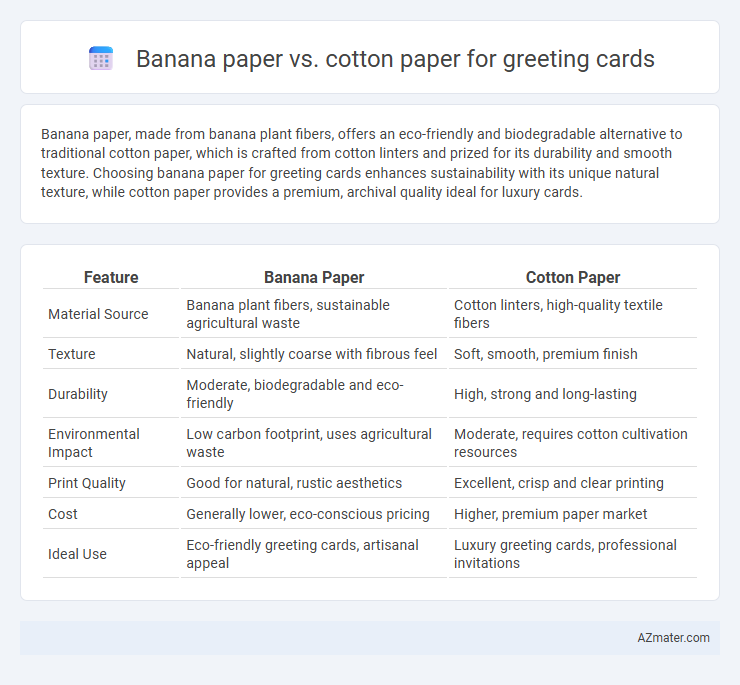Banana paper, made from banana plant fibers, offers an eco-friendly and biodegradable alternative to traditional cotton paper, which is crafted from cotton linters and prized for its durability and smooth texture. Choosing banana paper for greeting cards enhances sustainability with its unique natural texture, while cotton paper provides a premium, archival quality ideal for luxury cards.
Table of Comparison
| Feature | Banana Paper | Cotton Paper |
|---|---|---|
| Material Source | Banana plant fibers, sustainable agricultural waste | Cotton linters, high-quality textile fibers |
| Texture | Natural, slightly coarse with fibrous feel | Soft, smooth, premium finish |
| Durability | Moderate, biodegradable and eco-friendly | High, strong and long-lasting |
| Environmental Impact | Low carbon footprint, uses agricultural waste | Moderate, requires cotton cultivation resources |
| Print Quality | Good for natural, rustic aesthetics | Excellent, crisp and clear printing |
| Cost | Generally lower, eco-conscious pricing | Higher, premium paper market |
| Ideal Use | Eco-friendly greeting cards, artisanal appeal | Luxury greeting cards, professional invitations |
Introduction to Banana Paper and Cotton Paper
Banana paper, made from the fibrous waste of banana plants, offers an eco-friendly alternative to traditional cotton paper, known for its softness and durability derived from cotton linters. Cotton paper provides a luxurious texture and high absorbency, favored for premium greeting cards, while banana paper appeals with its sustainability and unique rustic aesthetic. Both materials present distinct advantages for greeting cards, balancing environmental impact with tactile quality.
Environmental Impact: Banana vs Cotton Paper
Banana paper offers a more sustainable alternative to cotton paper due to its use of agricultural waste, significantly reducing deforestation and water consumption. Cotton paper production requires intensive water and pesticide use, contributing to higher environmental degradation and resource depletion. Choosing banana paper supports eco-friendly practices by utilizing renewable materials and lowering carbon footprint in greeting card manufacturing.
Production Process Comparison
Banana paper is made by extracting fibers from banana plant stems, which are then cleaned, pulped, and pressed into sheets, utilizing agricultural waste and reducing environmental impact. Cotton paper production involves harvesting cotton linters, chemically processing them into pulp, and forming high-quality, durable sheets with a smoother texture. The banana paper process emphasizes sustainability and waste reduction, whereas cotton paper focuses on producing premium, long-lasting material with a more complex, resource-intensive manufacturing process.
Texture and Appearance Differences
Banana paper features a unique fibrous texture with visible natural strands, giving greeting cards an organic, rustic appearance ideal for eco-friendly themes. Cotton paper offers a smoother, softer texture with a luxurious, high-quality finish that enhances printed colors and details for elegant, refined cards. The distinct tactile properties of banana and cotton papers influence the overall aesthetic, making banana paper more textured and textured and cotton paper more polished and uniform.
Durability and Longevity
Banana paper offers excellent durability due to its strong natural fibers, often outlasting traditional cotton paper in resisting tears and wear. Cotton paper boasts superior longevity, with high resistance to yellowing and degradation over time, making it ideal for archival-quality greeting cards. Both papers provide unique benefits: banana paper excels in strength and eco-friendliness, while cotton paper ensures preservation and lasting aesthetic appeal.
Print Quality and Color Vibrancy
Banana paper offers a unique texture that absorbs ink differently, resulting in a matte finish with moderate color vibrancy, ideal for eco-friendly greeting cards. Cotton paper, known for its smooth and durable surface, enhances print quality by delivering sharper detail and richer, more saturated colors, making it a premium choice for high-end greeting cards. The choice between banana and cotton paper significantly impacts the visual appeal, with cotton paper excelling in print clarity and color depth.
Cost-Effectiveness for Greeting Cards
Banana paper offers a cost-effective alternative to traditional cotton paper for greeting cards, as it is made from banana fiber waste, reducing raw material expenses and environmental impact. While cotton paper provides premium durability and texture, it typically incurs higher production costs, making banana paper a budget-friendly choice without compromising quality. Choosing banana paper supports sustainable practices and can lower overall manufacturing expenses for greeting card businesses.
Eco-Friendly Branding Opportunities
Banana paper offers a unique eco-friendly branding opportunity by utilizing sustainable banana fibers, which reduce waste and deforestation compared to traditional cotton paper. Cotton paper, while biodegradable and recyclable, often requires significant water and pesticide use during cultivation, impacting its environmental footprint. Emphasizing banana paper in greeting cards aligns brands with innovative sustainability practices and appeals to environmentally conscious consumers seeking earth-friendly products.
User Experience and Customer Perception
Banana paper offers a unique tactile experience with its slightly fibrous texture, enhancing the organic and eco-friendly appeal of greeting cards, which appeals to environmentally conscious users. Cotton paper provides a smooth, luxurious feel often associated with high-quality craftsmanship, elevating the perceived value and durability of the card. Customers tend to view banana paper as innovative and sustainable, while cotton paper is favored for its traditional elegance and premium presentation.
Choosing the Right Paper for Your Greeting Cards
Selecting banana paper for greeting cards offers eco-friendly benefits with its renewable fiber content, giving a natural texture and rustic aesthetic. Cotton paper excels in durability and softness, providing a premium feel that enhances print clarity and longevity. Balancing sustainability with quality preferences helps determine the best paper choice for impactful greeting card designs.

Infographic: Banana paper vs Cotton paper for Greeting card
 azmater.com
azmater.com